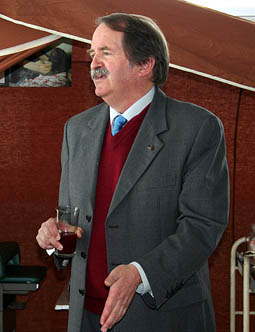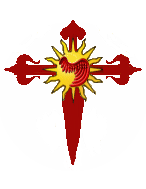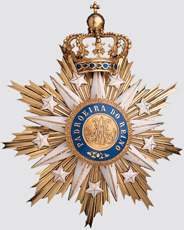
H.R.H Dom Duarte Duke de Bragança
House of
Brangança

H.R.H Dom Duarte Duke de
Bragança
Grand Master of
Order of Saint Isabel -
Established: 4 November 1801
by King John VI, in recognition for the devotion of Elizabeth of Aragon, the Queen
Saint consort of Portuguese King Denis I. John VI invested Carlota Joaquina,
his wife, as Grand Mistress of the Order. The Order is exclusively for Ladies
and it distinguished Catholic noble women. The total of members that this order
could have was twenty-six.

Royal Order of Saint Michael of the Wing - Established: 1147 by King Afonso I (The Order's first Statutes were approved by Pope Alexander III in 1171 and because of this fact the year 1171 is often referred to in error as the date of the Foundation.), to honor a group of knights of the Order of Saint James from the Kingdom of León who assisted him in retaking Santarém from the Moors on the Feast of Saint Michael, May 8, 1147. Originally, the order was formed from members of the Military Order of Saint James and thus the reason why it maintains on its Coat of Arms the red sword of this Order accompanied at the blade by thwo fleur de lis representing the Cistercian Rule its members observed at the Royal Abbey of Alcobaça Where the Order, along with 6 other Military Orders was headquarted until the reestablishment of all Orders as unarmed and non-military Orders of "Honorific Knighthood" in 1834. The Order's first Statutes were approved by Pope Alexander III in 1171 and because of this fact the year 1171 is often referred to in error as the date of the Foundation.
The order fell into disuse after 1733 and it was not included among the royal orders that were nationalized by the Portuguese Republic after the Revolution of 1910. It was restored by King Dom Miguel I in 1848 after he lost the Liberal War to his brother King Dom Pedro IV and given new Statutes whilst King Dom Miguel was living in exile in the Vatican. These Statutes restructured it as a Secret Military Order to combat Freemasonry and restore the Absolutist Monarchy in Portugal. Its activity was suspended however a decade later after the Pope prohibited all Secret Organizations Catholic or otherwise.
From that time on and until 1986 it was bestowed as an award by the descendants of King Dom Miguel who claimed the title of Grand Master by birth of the Order until in 1986, Duarte Pio, Duke of Braganza and pretender to the Portuguese Throne, informed the Holy See and the Portuguese Republic that he still considered himself to be the Grand Master of the order and that although he did not have the power to validly alter the Statutes a King had previously approved, he nonetheless still conferred it as an award and Knighthood of Merit.

Order of the Immaculate Conception of Vila Vicosa - Established: 6 February 1818 by King John VI, the date of his acclamation, in recognition for the efficient protection of the Kingdom's Spiritual Sovereign (Portugal is known as the Land of Santa Maria since its foundation). The Blessed Virgin Mother under the invocation of the Immmaculate Conception (venerated in the Ducal Chapel of the Palace of Vila Viçosa) had earlier been acclaimed "Queen" and Patroness of the kingdom by King John IV on March 25, 1646 following a referendum of the Empire that lasted 6 years and asked subjects: 1. If they believed the Blessed Virgin Mary to have been conceived without sin, and 2. If they believed that the Blessed Virgin Mary was the physical reigning Queen of Portugal and not just symbolically the Patroness. The people answered affirmatively and since the Coronation that took place at Vila Viçosa, the Kings of Portugal never again wore a crown.
This order distinguished those who proved their loyalty to the Portuguese Royal House in the war against the Bonapartist occupying forces.
Later, in 1818, a royal decree stated that the Order would be given as a military award in four (4) classes of Grand Cross, Commander, Knight, and Servant. Knighthood was given to those who were servants to the king and devoted Catholics to the pope and the Holy Mother.
The Order was originally limited to twelve Grand Crosses, forty Commanders and one hundred Knights, with the provision for the award of supernumerary Grand Crosses.
Grand Crosses were usually given to higher nobles who had positions in the Royal Household. Lower grades (Commander and below) were granted to lesser nobles who had provided personal service to the King.
